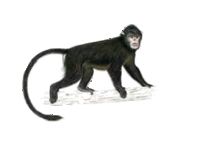
Rhinopithecus strykeri

The Myanmar snub-nosed monkey or black snub-nosed monkey (Rhinopithecus strykeri) is a critically threatened species of colobine monkey discovered in 2010 in northern Burma (Myanmar). It was formally described as a novel species of primate in 2011 based on its fur, beard and tail. Two groups of the species were discovered in China in 2011 and 2015, respectively. The species is known in local dialects of Lisu people as mey nwoah and Law Waw people as myuk na tok te, both of which mean 'monkey with an upturned face'.Rain allegedly causes it to sneeze due to the short upturned nasal flesh around its nostrils. People from the area report that it sits with its head directed downwards, hiding its face between its knees when it rains. The species came to the attention of a team of scientists allied to the 'Myanmar Primate Conservation Program' researching the status of the hoolock gibbon in early 2010. The team, led by Swiss primatologist Thomas Geissman and Ngwe Lwin of the Myanmar Biodiversity and Nature Conservation Association (BANCA), were supported by Fauna & Flora International (FFI) and the People Resources and Conservation Foundation (PRCF). The specific name strykeri is given in honour of philanthropist Jon Stryker, president and founder of the Arcus Foundation, which also sponsored the project. The type specimen was identified from the Maw River area of northeastern Kachin state in northeastern Burma. The specimen most closely examined was the skull (with mandible) and skin of a gutted adult male obtained from hunters in Pade, subsequently deposited in the Anthropological Institute and Museum of the University of Zürich. Additional sample skulls of animals killed some three years earlier, one male and one female, were also collected along with a bag made out of the skin of a juvenile caught in January 2010, all obtained in Htantan village. The team encountered seven live specimens, including an infant, but these moved out of sight before they could be photographed or studied in detail. A camera trap set by a team of FFI, BANCA and PRCF researchers captured the first known images of live snub-nosed monkeys in January 2012. The monkey's fur is mostly black. Its crown consists of a thin, high, forward-curved crest of long, black hairs. It has protruding white ear tufts, a mostly naked face with pale pink skin, a “moustache” of whitish hairs above the upper lip, and a distinct white chin beard. The perineal area is white and clearly defined, and the limbs are mostly black; the inner sides of the upper arms and upper legs are blackish brown. The lips are prominent, and the nose upturned, allegedly causing the animal to sneeze in rainy weather. Its tail is approximately 1.4 times the body length: the first sample, an adult male, has a head-body length of 55.5 centimetres (21.9 in), and a tail 78 cm (31 in) long. The species spend summer months in temperate mixed forests at upper altitudes of their range, and descend to lower ground in the winter to escape snow. When first discovered, the only known specimens existed in three or four groups within a 270 square kilometres (100 sq mi) range at 1,700 to 3,200 metres (5,600–10,500 ft) above sea level in the eastern Himalayas, in the north-eastern section of Kachin State, the northernmost part of Burma (Myanmar). In 2011, a population was discovered in Pianma, Lushui County, Yunnan, China. The species is isolated from other snub-nosed Rhinopithecus by the Mekong and the Salween rivers; the other 4 species, golden, black, gray and Tonkin snub-nosed monkeys, are found in China and Vietnam. The species shares habitat with Shortridge's langur, stump-tailed macaque, Assam macaque, rhesus macaque, and northern pig-tailed macaque.
